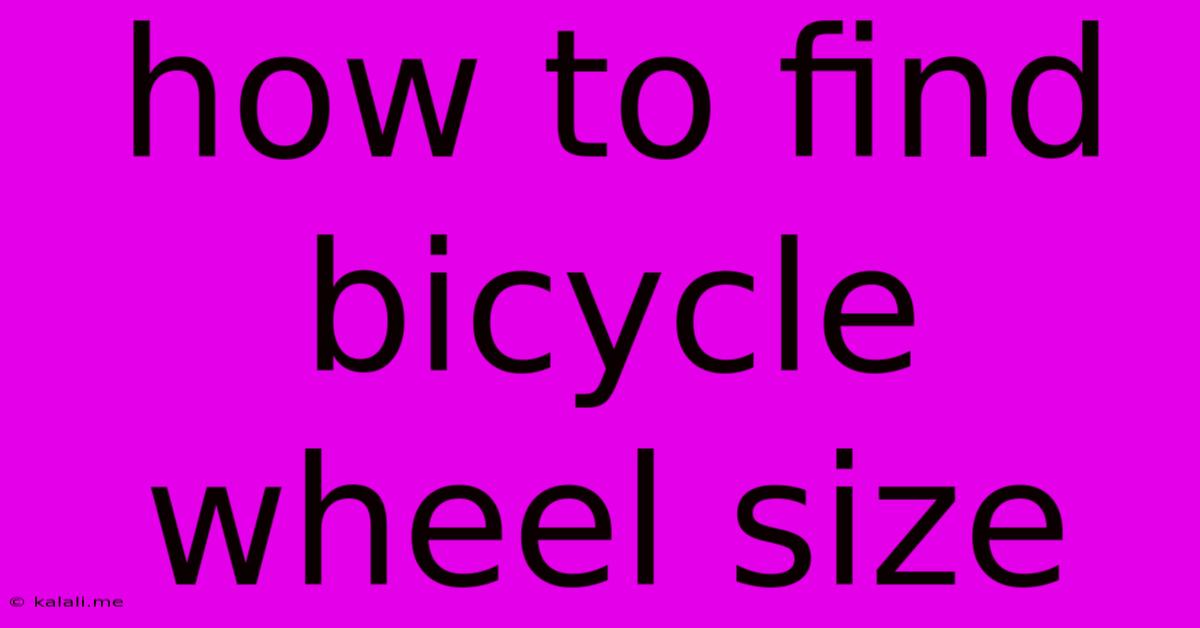How To Find Bicycle Wheel Size
Kalali
May 29, 2025 · 3 min read

Table of Contents
How to Find Your Bicycle Wheel Size: A Comprehensive Guide
Finding the right bicycle wheel size is crucial for a safe and comfortable ride. The wrong size can lead to poor performance, compatibility issues, and even accidents. This guide will walk you through various methods to determine your bike's wheel size, ensuring you get the perfect fit. Understanding your wheel size is essential for repairs, upgrades, or simply replacing a worn-out tire.
Understanding Wheel Size Terminology
Before we dive into finding your wheel size, let's clarify the terminology. Bicycle wheel sizes aren't as simple as just a single number. You'll commonly encounter these measurements:
-
ISO (International Organization for Standardization) Size: This is a precise measurement in millimeters (mm) of the wheel's diameter (the distance across the wheel). For example, a 700c wheel is approximately 622mm in ISO size.
-
ETRTO (European Tyre and Rim Technical Organisation) Size: This system specifies both the rim diameter (in mm) and the rim width (in mm). For example, a 622-18 represents a rim with a 622mm diameter and an 18mm width.
-
Inch Size (e.g., 26", 27.5", 29"): This is an older system and less precise, often found on mountain bikes. These measurements refer to the approximate diameter of the wheel. However, even within these sizes, there are variations.
Methods to Determine Your Bicycle Wheel Size
Here are the most reliable ways to find your bicycle wheel size:
1. Check the Sidewall of Your Tire: The easiest method is to look at the sidewall of your tire. The tire size is printed there, often including the ETRTO size (e.g., 26 x 1.95 or 559-40). The first number (559) is the crucial part—your rim diameter in millimeters.
2. Examine the Rim Itself: The rim might have the ETRTO size stamped or printed on it. Look for numbers like "622" or "559". This directly indicates the wheel's diameter in millimeters.
3. Measure the Wheel Directly: This is a more hands-on approach, but accurate. Use a flexible measuring tape to measure the diameter of your wheel across the widest point. This is the outermost part of the tire. Subtract twice the tire width to get the approximate rim diameter.
4. Consult Your Bicycle's Manual or Documentation: If you still have the original documentation that came with your bicycle, it should list the specifications, including the wheel size.
5. Look at the Bike's Frame: While not a direct measurement, the frame size often corresponds to certain wheel sizes. Smaller frame sizes are commonly associated with smaller wheels (e.g., 26"), while larger frames usually use larger wheels (e.g., 700c or 29"). This method is less reliable on its own but can be helpful when used alongside other methods.
Converting Wheel Sizes
If you've found a wheel size in inches, you may need to convert it to the more accurate ISO or ETRTO standard for compatibility. While there are no perfect conversions, online conversion charts are readily available to give you a close approximation. However, relying on the sidewall or rim markings is the most precise and reliable approach.
Ensuring Compatibility
Once you've determined your wheel size, always verify compatibility with your existing frame, fork, and brakes before purchasing replacements. Different wheel sizes may not fit within the frame or may interfere with the brakes, leading to potential safety risks.
By following these steps, you can confidently determine your bicycle wheel size and ensure a smooth and safe cycling experience. Remember that accurate wheel size identification is critical for proper maintenance, upgrades, and ensuring a perfect fit for your bicycle.
Latest Posts
Latest Posts
-
How Do I Fix Squeaky Floors
May 30, 2025
-
Why Does My Cat Scratch The Wall
May 30, 2025
-
Should Rotors Be Changed With Brake Pads
May 30, 2025
-
How To Say Checking In Spanish
May 30, 2025
-
Does It Mean To Wear Your Heart On Your Sleeve
May 30, 2025
Related Post
Thank you for visiting our website which covers about How To Find Bicycle Wheel Size . We hope the information provided has been useful to you. Feel free to contact us if you have any questions or need further assistance. See you next time and don't miss to bookmark.